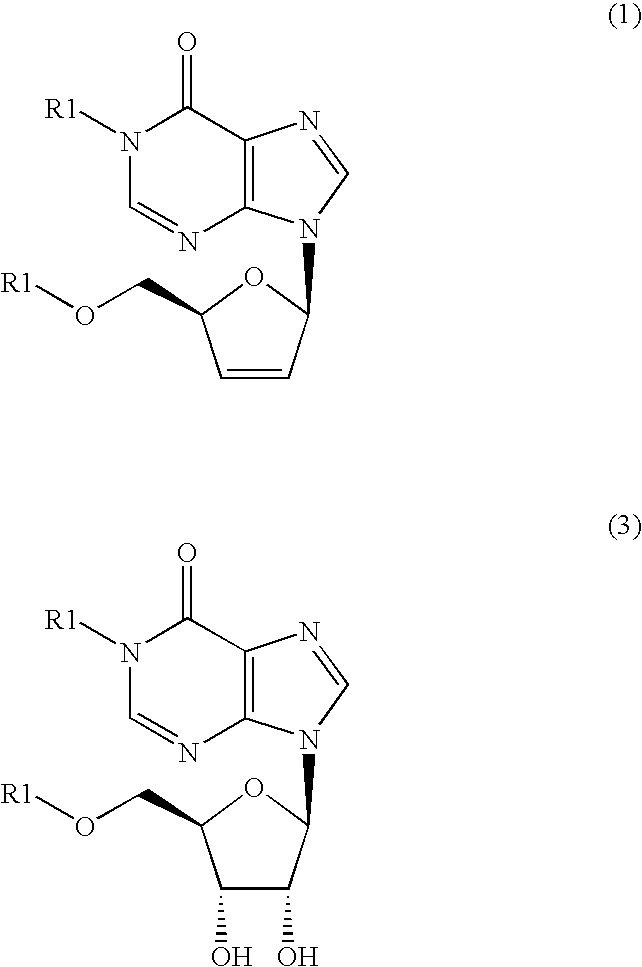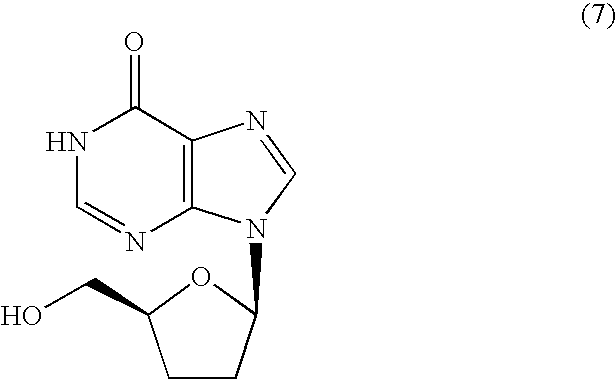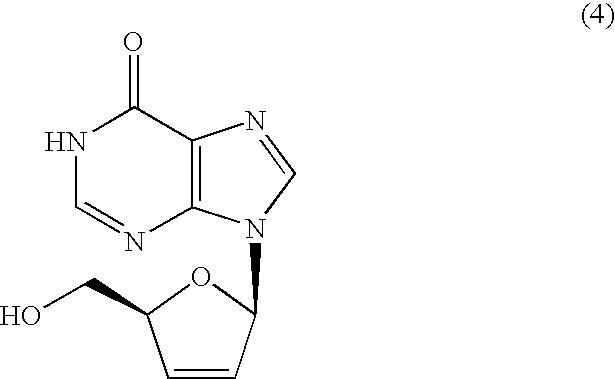Inosine derivatives and production methods therefor
a technology which is applied in the field of inosine derivatives and production methods therefor, can solve the problems that there is no known production method for ddi from the above-mentioned compound, and achieve good yields
- Summary
- Abstract
- Description
- Claims
- Application Information
AI Technical Summary
Benefits of technology
Problems solved by technology
Method used
Image
Examples
example 1
Synthesis of N1, 5′-O-dibenzyl-2′,3′-bis-O-[(methylthio)thiocarbonyl]inosine
[0069] To a dimethyl sulfoxide solution (1 mL) of N1,5′-O-dibenzyl inosine (224 mg, 0.5 mmol) synthesized in accordance with a method described in Luzzio, F. A. et al. J. Org. Chem., 1994, 59, 7267-7272, an aqueous solution of sodium hydroxide (0.28 mL, 1.1 mmol) at a concentration of 4.0 mol / L and carbon disulfide (0.09 mL, 1.5 mmol) were added, and the obtained mixture was stirred at room temperature for 2 hours. To the obtained solution, methyl iodide (0.07 mL, 1.1 mmol) was added dropwise, the mixture was then stirred at room temperature for one hour. Then, with the addition of ethyl acetate (10 mL) and water (2 mL), the reaction was terminated. After the layers were separated, the resultant water layer was again extracted by the addition of ethyl acetate (10 mL). The two organic layers thus obtained were combined and dried over anhydrous magnesium sulfate, and then concentrated under reduced pressure. ...
example 2
Synthesis of N1,5′-O-dibenzyl-2′,3′-didehydro-2′,3′-dideoxyinosine
[0071] An acetonitrile solution (1 mL) of N1,5′-O-dibenzyl-2′,3′-bis-O-[(methylthio)thiocarbonyl]inosine (314 mg, 0.5 mmol) was heated to 80° C. To this solution, an acetonitrile solution (1 mL) of N-ethylpiperidine hypophosphite (358 mg, 2 mmol) and 2,2′-azobisisobutyronitrile (16.4 mg, 0.1 mmol) were added, and the mixture was then stirred at 90° C. for one hour. After the reaction mixture was cooled, the reaction was terminated with the addition of water (3 mL). The reaction mixture was extracted by the addition of ethyl acetate (15 mL), and the resultant organic layer was dried over anhydrous magnesium sulfate and concentrated under reduced pressure. After purification by chromatography (using 12 g of silica gel and a mixed solvent of hexane and ethyl acetate (1:2) as an eluting solution), 150 mg of the intended product was obtained in a yield of 71% as a colorless oily material.
[0072]1H-NMR (CDCl3): δ 3.61 (d, ...
example 3
Synthesis of N1,5′-O-dibenzyl-2′,3′-dideoxyinosine
[0073] To a methanol solution (1 mL) of N1,5′-O-dibenzyl-2′,3′-didehydro-2′,3′-dideoxyinosine (207 mg, 0.5 mmol), 5% palladium-carbon (20 mg) was added, and the mixture was stirred at room temperature for 2 hours in an atmosphere of hydrogen (1 atm). The palladium catalyst was removed from the obtained reaction mixture by filtration, and the resultant filtrate was concentrated under reduced pressure. After purification by chromatography (using 15 g of silica gel and ethyl acetate as an eluting solution), 187 mg of the intended product was obtained in a yield of 90% as a white solid.
[0074]1H-NMR (CDCl3): δ 2.08-2.17 (m, 2H), δ 2.40-2.49 (m, 2H), δ 3.59 (d-d, 1H, J=10.5, 4.4 Hz), δ 3.73 (d-d, 1H, J=10.5, 3.3 Hz), δ 4.30-4.40 (m, 1H), δ 4.55 (d, 1H, J=12.2 Hz), δ 4.60 (d, 1H, J=12.2 Hz), δ 5.24 (d, 1H, J=14.7 Hz), δ 5.28 (d, 1H, J=14.7 Hz), δ 6.24 (d-d, 1H, J=6.5, 3.3 Hz), δ 7.27-7.37 (m, 10H), δ 7.97 (s, 1H), δ 8.14 (s, 1H). 13C-NMR ...
PUM
| Property | Measurement | Unit |
|---|---|---|
| temperature | aaaaa | aaaaa |
| temperature | aaaaa | aaaaa |
| reaction time | aaaaa | aaaaa |
Abstract
Description
Claims
Application Information
 Login to View More
Login to View More - R&D
- Intellectual Property
- Life Sciences
- Materials
- Tech Scout
- Unparalleled Data Quality
- Higher Quality Content
- 60% Fewer Hallucinations
Browse by: Latest US Patents, China's latest patents, Technical Efficacy Thesaurus, Application Domain, Technology Topic, Popular Technical Reports.
© 2025 PatSnap. All rights reserved.Legal|Privacy policy|Modern Slavery Act Transparency Statement|Sitemap|About US| Contact US: help@patsnap.com



